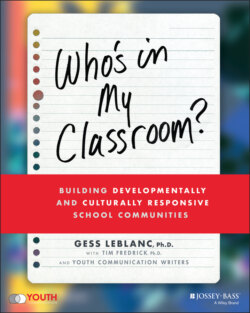Читать книгу Who's In My Classroom? - Tim Fredrick - Страница 24
What Schools Can Do 1. Assess how students’ developmental needs are currently being met.
ОглавлениеTo measure growth in student learning, all schools gather baseline data about students at the beginning of the school year and compare it with end-of-year data to determine changes in skills and knowledge. In the same way that schools gather baseline data on students, I also recommend that they gather baseline data on the ways the school meets the developmental needs of their students.
As we discussed throughout this chapter, students have critical cognitive, physical, social, and emotional needs that, when supported, lead to better academic performance and other positive outcomes.
Hence, a key question that school personnel should explore and quantify is: “How well are we currently addressing those needs?” To address students’ cognitive needs, schools can look at indicators that address students’ needs to feel competent. For example, how does the school provide opportunities for students to demonstrate their competence beyond grades and test scores?
Irving describes a moment like that:
One year, I found a writing program I wanted to join, but because I was in special ed I didn't meet the academic requirements. When Ms. Ackert found out, she was red with rage.
She told me to make a poster board that displayed all my writing. She wanted me to present it to the principal, and to tell him I deserved to join the program. I did, and in the end he was impressed with my work and actually recommended me for an even better writing program.
To address students’ physical needs, look at whether the school is providing opportunities for movement throughout the day. As you have probably noticed, most professional development workshops include activities where participants get up and move because long periods of sitting makes many adults antsy. Yet movement is seldom worked into lessons with adolescents, with predictable consequences. Schools should review school discipline statistics to determine if discipline referrals are triggered by students getting out of their seats or moving in their seats in ways that distract other students. This could indicate that their physical needs are not being met.
To support students’ social and emotional needs, school administrators and school personnel should assess well how their curriculum currently includes lessons that build social and emotional skills in ways that align with state-level benchmarks such as the New York State Social and Emotional Learning Benchmarks (NYSED, 2018). For example, to support the development of social awareness and relationship skills they should also reflect on whether students have appropriate opportunities for peer-based activities in which students must work together to achieve a common goal. In classes like English and social studies, teachers can help students identify and name the social and emotional elements inherent in character development or political conflicts, for example.
Of course, having staff model social and emotional skills is even more powerful than teaching them. Successful schools also ensure that school personnel learn the language of SEL competencies and learn to recognize their own strengths and challenges in relation to those competencies. The Youth Communication website, https://www.youthcomm.org/curriculum-training/#curricula, has SEL resources and professional development that are designed to strengthen students’ and staff members’ SEL skills for grades 6 to 12.
